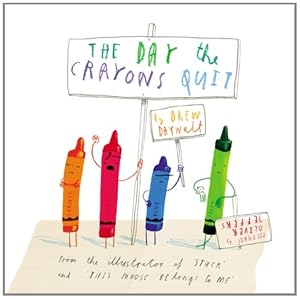The Day the Crayons Quit
Written by Drew Daywalt
Illustrated by Oliver Jeffers
Grade:1-3
Click here for links to other lesson plan ideas and special author and illustrator information- including interviews!
Summary:
One
day, Duncan went to open his box of crayons and instead found a bunch of
letters addressed to him. His crayons had gone on strike! Each crayon left its
own letter explaining why they are protesting. Red crayon says it is overworked
and does not like that it has to work extra hard on holidays (hearts for
Valentine’s Day, Santa on Christmas, etc.). Purple crayon wants Duncan to start
working harder to color in the lines. Beige crayon wants to be labeled correctly
(not “light brown” or “dark tan”) and wants to be used as much as Brown crayon.
Gray crayon would like to be used to color smaller things and get a break from
having to fill in such big animals like elephants. White crayon expresses
feelings of emptiness, since it can never really be seen on paper. Black crayon
wants to be used as more than just an outline. Green crayon loves his work, but
wanted to tell Duncan about Orange and Yellow fighting. Orange crayon and
Yellow crayon both think they are the correct color for the Sun. Blue crayon
has been used so much he is down to just a little nub! Pink crayon has not been
used and does not think it is a girl color. Peach crayon has been left naked,
with no wrapper, and is too embarrassed to leave the box. In the end, Duncan
creates a brand new picture to make all of his crayons happy!
Element 5: Raising Awareness
In this
book, the crayons all get together and stand up for themselves by making their
feelings known and going on strike. Each letter in the book addresses the
specific problem of each individual crayon. This book introduces students to friendly
letter-writing as a way of expressing oneself against what they feel is unjust.
Students learn they do not always have to go along with situations they do not
agree with. They are able to make their feelings known and can do so in a calm
and polite manner. Although this is not about a specific historical social
issue, the characters in the story are raising awareness about their own
personal issues. In the end, the crayons are successful in creating change by
raising awareness and making their feelings known.
Activity:
As an
activity to go along with this we can create a class “suggestions/comments box”.
To start it off each student will write a letter about something either they do
not like that is happening (like the red or gray crayons), they are feeling
(like the white crayon), a problem with another peer (like the orange and
yellow crayons), or something they think is going really well (like the green
crayon). Students will be able to
practice spelling and grammar as well as proper letter-writing format. They
will get practice in organizing their thoughts in a clear, productive, and
friendly way. The teacher will make sure to go through the box and address as
many of the issues from the students as possible, and hopefully all of them.
Maybe a day could be spent with them discussing each issue (of course leaving
out names and more personal issues- those students could be spoken to
privately) so each student gets a say and a vote on how to deal with the
problems. They will be able to understand that change is possible when you
speak up and that everyone is allowed an opinion.

No comments:
Post a Comment